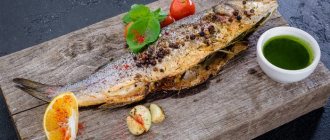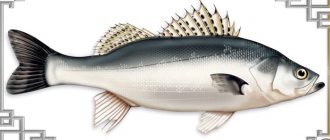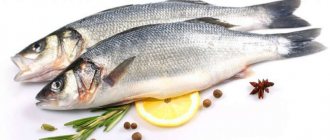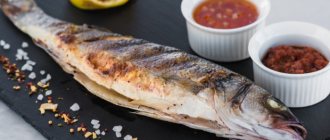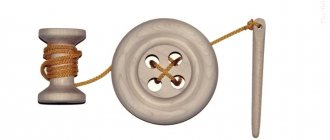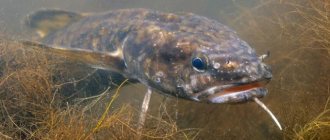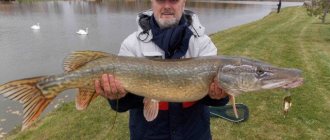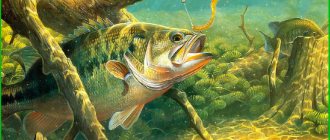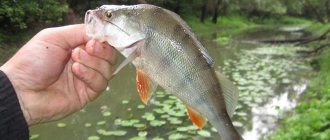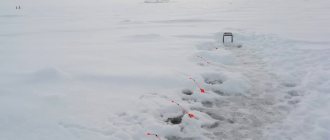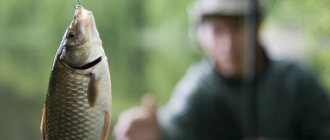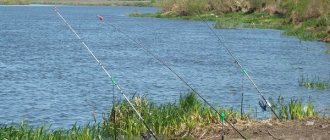Bayfish is very popular in many European countries, both in the gastronomic world and is a desired trophy among amateur fishermen and athletes.
Has many names. A predator with a cautious, even timid character, the omnivorous glutton is capable of making the fisherman run along the shore, teasing him with his presence.
How to outwit the Mediterranean insolent? What gear and bait to use when catching it, how to lure it and get the long-awaited trophy? You will find answers to these questions and more in this article.
Content
- 1. General description of sea bass (sea bass)
- 2. Distribution and habitats in Israel
- 3. Age and size
- 4. Lifestyle of sea bass
- 4.1. Reproduction - time and characteristics of spawning
- 4.2. Diet - what does sea bass eat?
- 5.1. Biting calendar - what time of year and day is best to catch sea bass (sea bass)
- 5.2. What is the best weather to catch sea bass?
- 5.3. What are the best places to fish?
- 5.4. What gear is best to catch sea bass?
- 5.5. Baits for catching sea bass
- 5.6. What baits and baits are used to catch laurel (sea bass)
- 5.6.1. Animal nozzles
- 5.6.2. Artificial baits
General description of sea bass (sea bass)
In the Mediterranean Sea you can catch two types of this fish: common (European) laurel and spotted laurel .
Common laurel has an elongated “torpedo” body, covered with tiny scales, with a silver color on the sides and an olive tint on the back.
Nature has endowed him with a large mouth, teeth located in a wide strip in the center of the mouth and tapering at the edges.
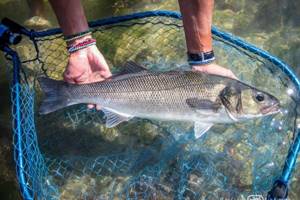
Spotted laurel (sea bass) is the younger brother of the European one. It is significantly inferior in size and differs in appearance - it has spots on the upper part of the body, “scattered” in a chaotic manner.
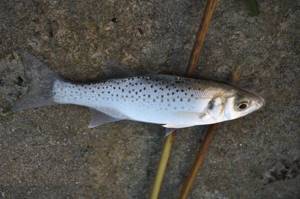
Other names for this fish used in various European countries:
- sea wolf;
- koykan;
- sea bass or English sea bass;
- sea pike perch;
- sea bass;
- lubina (Spanish lubina);
- branzino or brandzino;
- spigola;
- rano (Italian: branzino, spigola, ragno).
General description and types
Active breeding of sea bass is due to a number of factors. These include:
- sea bass has a very delicate, soft and pleasant taste,
- their meat contains a small amount of calories,
- There are few bones in the sea wolf.
It is thanks to these properties that sea bass has long been often used in the field of nutrition.
The most common varieties are the common and Chilean (black) laurel. Common wild sea bass is found mainly off the east coast of the Atlantic. It has an elongated body and a strong skeleton. This variety has silver inclusions on its sides. The length of the species reaches 55 cm. Life expectancy varies from 10 to 15 years.
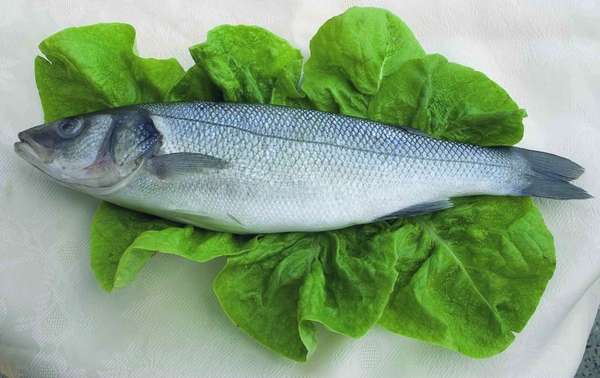
The Chilean sea bass is more common on the west coast of the Atlantic Ocean. Sea bass does not tolerate heat well, loves depths and has pointed fins on its back. This variety is called black because of its corresponding color. However, the fish can look different, changing colors from gray to brownish - depending on conditions and mood.
Lifestyle of sea bass
Spotted sea bass stays in groups, lives in surf zones (at a depth of no more than 30 m), rich in oxygen and abrupt descents to deep-sea areas.
Leads a predatory lifestyle. Common laurel also lives in small groups. Mature (large) individuals prefer solitary swimming.
4.1. Reproduction - time and characteristics of spawning
Spawning period in the Mediterranean Sea: from May to August. At this time, sea bass can be seen not far from the shore, and can also be found at the mouth of the river or in the river itself.
4.2. Diet - what does sea bass eat?
It hunts in schools, quickly attacking small fish: horse mackerel, anchovy, sprat or sardine. When hunting or searching for food, sea bass enters port areas and shallow coastal areas, where it feasts on shrimp, worms, crabs and shellfish.
At dawn, if small fish jump out of the water in such coastal places, it means that laurel may be hunting here.
How, where, when and what to catch
Fishing occurs year-round and around the clock in coastal areas. The main fishing methods used are fly fishing and spinning.
5.1. Biting calendar - what time of year and day is best to catch sea bass (sea bass)
Spotted bay laurel is active throughout the day. Catching the predator occurs all year round, but is considered especially successful from December to April.
5.2. What is the best weather to catch sea bass?
Active biting is observed after a storm, when all the small sea creatures are carried to the shore by the waves. Successful fishing from piers and moorings will be at dawn in calm and windless weather.
The ideal water temperature for bay laurel is 18 degrees.
5.3. What are the best places to fish?
Spotted sea bass can be caught in the same areas as regular sea bass.
Sea bass habitats:
- rocky areas;
- sandy bottom with algal vegetation;
- breakwater zones;
- coastal rocks;
- piers;
- berths;
- seaports (especially in waste disposal areas).
5.4. What gear is best to catch sea bass?
If fishing takes place from a pier, then the best tackle will be a float rod for long-range casting, equipped with a sinking sinker.
Equipment example:
- small bulldo;
- leash at least 1.5 m long;
- hook No. 8-9.
When using a spinning rod, it is better to use a thin fishing line or braided line, since bay laurel is shy in nature and easily notices the equipment.
Example of rod equipment:
- tackle length is at least 4 m with dough from 60 g;
- inertia-free reel with salt protection (with a baitrunner system);
- the main line is from 20 to 25 mm long, transparent, fast-sinking and durable;
- weight weighing 45 - 65 g (elongated and flat);
- sharp hooks No. 6, 7, 8.
Sea bass is also caught with fly fishing gear.
Advice:
- It is possible to use different types of cords (slow, floating, fast-sinking, etc.).
- The rod is recommended for use in 7th - 8th class.
5.5. Baits for catching sea bass
The following are used as bait:
- pieces of small fish;
- crustaceans (shrimp, crabs).
Method of preparing bait: finely chopped pieces of crabs (shrimps) and fish are mixed in a container. Flavorings are added to the resulting minced meat (for example, juice from fish meat, preferably from sardines). Next, the mixture is placed in a feeder, from which, when it gets into the water, it is gradually washed out, leaving behind a long and fragrant trail of fishy smell. The feeder is equipped with a sinker for lowering to the seabed.
5.6. What baits and baits are used to catch laurel (sea bass)
Animal baits Rating of the best animal baits:
- Live bait is any small fish with a light color. This bait is attached to a hook under the dorsal fin. It is recommended to use a tackle with two leashes, where one hook is attached near the edge of the ridge, and the other - the lip. The sting of the hooks must be free in order to be sure to enter the bony jaw of the predator.
- Shrimp. The main thing is that the bait is live (fresh), since when it spoils it loses its pink color, and the catchability of the fish decreases.
- Squid pieces.
- Worm (Nereis, Dendrobena).
- Cuttlefish.
- Octopus.

Artificial baits:
- wobblers (for example, transparent “strike-pro” from 5 to 7 cm, “yo-zuri Mag/TX” from 9 to 13 cm;
- silicone baits (for example, “roglou”, “delta” measuring from 5 to 9 cm, white or gray);
- castmaster;
- front sight;
- spinners (flat spoons);
- poppers;
- octopuses;
- artificial fish (used when fishing from rocky areas).
Possible combinations of artificial attachments:
- fly and spoon;
- twister and wobbler;
- wobbler and wobbler;
- and other options.
Tactics for using bait in different weather conditions:
- in calm conditions and waves up to 0.5 m - small size top water;
- wave from 1 m with foam - wobblers from 70 to 150 mm or top water.
What colors of bait should I use at different times of the day?
- dawn - white, silver, white-yellow;
- early morning – red, white, blue colors;
- from lunch to evening - white;
- in the dark - black and purple colors of the nozzles.
What designs to use?
- floating;
- lefty receiver;
- sandiil or clauser (when fishing in deeper areas of water).
Advice:
- when using artificial attachments, the wiring is intermittent;
- When fly fishing, it is better to use slow-sinking artificial shrimp and flies;
- the search for fish can be started, for example, with a transparent (light) wobbler “sammy” (in common parlance sammik) size 65-85-100, then if there is no bite, you can use a small yellow (or regular) castmaster or with white (transparent) “minnoshki” sizes from 50 to 90 mm.
It’s better to start fishing with smaller baits and gradually increase their size.
You can read more detailed information about the use of baits, based on practical experience in sea bass fishing, on the forum pages https://spinningist.com/forum/23-929-1 or https://beseder.net/forum/viewtopic.php? p=136940
5.7. How does it get caught on a hook?
Before hooking, the bay laurel examines the bait and is careful.
5.8. How to catch sea bass correctly. Basic techniques.
Since bay laurel is capable of chasing prey all the way to the shore, wiring should be carried out to the very end.
When using float gear, the casting guide is the “laurel wave” - a water area where the water foams from the waves. The cast should be made 2 or 3 m beyond this foamy area.
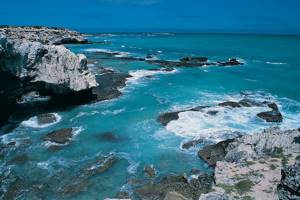
Secrets of fishing with float tackle:
- places - rocky shores, boulders;
- small waves;
- use sensitive gear, but high-quality and durable;
- use strong fishing line;
- use small and sharp hooks;
- sensitive float.
When spinning fishing, it is recommended to do the wiring slowly from the foamy water to the very shoreline. The best option in choosing a fishing location is rocky shores at high tide, and the time of day is evening or night.
Important!
- You need to hook the fish when you are sure of its strong hold. Lavrak is a cautious fish.
- Don't do hasty wiring.
5.9. The most important points when catching sea bass (sea bass)
- While fishing, you need to be constantly looking for fish in coastal areas; fishing in one place may not bring results.
- It is better to throw the bait over the crest of the wave and lead it to the next one; if it is covered by a wave, then wait not long and then continue fishing.
- Since fishing also involves wading, it is better to place everything you need in a bag on your belt.
How to cook?
How to cook bay fish tasty and simple? There are a lot of options, so only a few are discussed below.
Option one
You will get a delicious dish if you simply fry this fish. Here's what you'll need:
- two medium or three small sea bass;
- one lemon;
- three cloves of garlic;
- rosemary branch;
- sprig of thyme;
- two or three tbsp. l. olive oil;
- 40-50 g butter;
- salt to taste.
Preparation:
- First prepare the fish. Clean and gut it completely, cutting off the tails and heads, as well as the fins. Rinse each carcass well and make slanting cuts on the sides.
- Next, make the marinade. Squeeze the lemon and mix half of its juice with olive oil, salt, pre-chopped herbs (for example, chopped or simply picked), as well as garlic, which can be chopped. Immerse the fish in this mixture and leave for half an hour or forty minutes without putting it in the refrigerator.
- After marinating in a frying pan, melt and boil the butter. And when it stops foaming, shake each fish a little from the marinade and fry on both sides until golden brown. If the fish are large, then you can simmer them for three minutes under the lid so that the meat inside is also well cooked.
- Next, remove the fish and place it in some container. And pour the other half of the lemon juice into the remaining oil in the pan. After boiling, pour this mixture over the bay leaf and leave for literally ten minutes so that all the pulp is soaked.
Option two
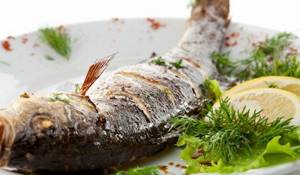
You can simply bake bay leaf in the oven, and it will absolutely turn out tasty and juicy if you add some spices to it.
List of ingredients:
- one large laurel;
- one lemon;
- Provençal herbs or other seasonings as desired, but compatible with sea fish;
- two tbsp. l. olive oil;
- salt.
Instructions:
- The bay laurel carcass must be cleaned and gutted; the tail, fins and head are cut off. Make several transverse or diagonal cuts on the sides.
- The fish should be salted, rubbed with olive oil and herbs. Also sprinkle it with a little lemon juice. Place thin lemon slices into the slits.
- Carefully wrap the bay leaf with foil, preferably a double layer. There should be no gaps left so that the flesh is as tender as possible.
- Send the fish to bake in the oven at a temperature of about 180 degrees for no longer than twenty-five to thirty minutes.
Option three
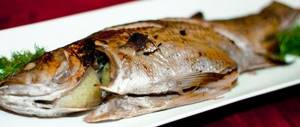
This recipe is more interesting and original, since the taste of bay laurel is emphasized by other ingredients.
Here's what you'll need to prepare:
- three medium laurels;
- a quarter cup of olive oil;
- 150 g zucchini;
- a pinch of oregano;
- 200 g cherry tomatoes;
- a pinch of rosemary;
- a mixture of peppers or one ground white pepper;
- salt.
Process description:
- After cleaning and gutting the bay leaf, rub with a small amount of olive oil, as well as ground pepper, salt and herbs, leave for twenty minutes to marinate.
- Cut the zucchini into cubes (you can cut off the skin if it seems dense to you), and simply cut the cherry tomatoes into halves.
- Heat the oil in a frying pan, fry the cherry tomatoes and zucchini over medium heat, and finally add salt to the ingredients.
- Fry the bay leaves in the same oil for literally one minute on each side.
- Grease the bottom of a baking sheet or baking dish (it is advisable to use a ceramic or glass container), place cherry tomatoes and zucchini on it, and place bay leaves on top.
- Bake the dish in the oven at 170 degrees for literally fifteen or twenty minutes.
